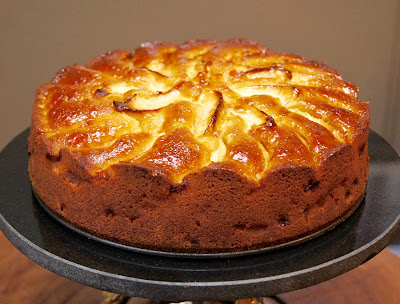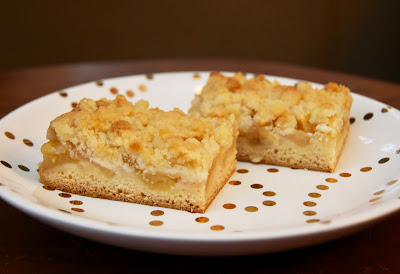I recently purchased a copy of Classic German Baking after reading a positive review of the book by Melissa Clark in The New York Times. I haven't had time to read through the entire cookbook yet and it's going to take me a while -- it includes a lot of desserts I'm not familiar with and the dearth of photos means I can't pick out recipes just by looking at the pictures. But I was able to quickly identify the first two recipes I wanted to try, both of which were cakes with apples and almonds. Almond is my favorite flavor in desserts, period. And I've gotten into the habit of buying apples at our farmer's market so I almost always have some on hand.
The first recipe I tried was "Apfel-Marzipan-Kuchen," or "Apple-Almond Cake." Weiss writes that her recipe is based on one that was printed on the back of a packet of almond paste. There is no photo in the cookbook, but the description drew me in. The headnote says: "This cake is epic. The crumb is so incredibly tender, it's almost creamy... You can't taste the almond paste outright but it gives the crumb an ineffable richness."
The cake comes together quickly. It calls for six small apples and also provides a weight equivalent of 800 grams. I used four Gold Rush apples that weighed 860 grams whole and 680 grams after peeling and coring. I diced two of the apples and cut the other two into slices, tossing all of the cut apples in lemon juice. To make the batter, you combine grated almond paste with melted butter and salt; beat in sugar and almond extract; add eggs; incorporate the dry ingredients (flour, cornstarch, baking powder); and fold in the diced apples. The recipe calls for seven ounces of almond paste but I was using Solo brand, which comes in an eight-ounce package, and I used all of it. In my experience, Solo paste is much softer than Odense (which does come in a seven-ounce package), and while I grated it as directed in the recipe, it was soft enough that I probably didn't need to. I poured the batter into a buttered and parchment-lined springform pan, and arranged the sliced apples on top in concentric circles.
The recipe says to bake the cake for 70 minutes, but when I tested it at that point a toothpick came out covered in wet batter, so I baked it for another 10 minutes. I wish that I had tented the cake with foil about halfway through baking because the top was quite dark by the time the cake was cooked through; the edges of a few of the apple slices were just slightly singed. I did err on the side of overbaking the cake because it was so tall, and in my opinion there are few things more tragic than an undercooked cake. Right after I took the cake out of the oven I brushed a thin layer of hot apricot jam on top, which gave the cake and fruit a beautiful shiny appearance.
Recipes: "Apfel-Marzipan-Kuchen" and "Apfelkuchen" (variation with "Mandelstreusel" almond streusel) from Classic German Baking by Luisa Weiss.
Previous Post: "Right-Side Up and All Right: Marcus Samuelsson's Apple Cake," January 10, 2017.
The first recipe I tried was "Apfel-Marzipan-Kuchen," or "Apple-Almond Cake." Weiss writes that her recipe is based on one that was printed on the back of a packet of almond paste. There is no photo in the cookbook, but the description drew me in. The headnote says: "This cake is epic. The crumb is so incredibly tender, it's almost creamy... You can't taste the almond paste outright but it gives the crumb an ineffable richness."
The cake comes together quickly. It calls for six small apples and also provides a weight equivalent of 800 grams. I used four Gold Rush apples that weighed 860 grams whole and 680 grams after peeling and coring. I diced two of the apples and cut the other two into slices, tossing all of the cut apples in lemon juice. To make the batter, you combine grated almond paste with melted butter and salt; beat in sugar and almond extract; add eggs; incorporate the dry ingredients (flour, cornstarch, baking powder); and fold in the diced apples. The recipe calls for seven ounces of almond paste but I was using Solo brand, which comes in an eight-ounce package, and I used all of it. In my experience, Solo paste is much softer than Odense (which does come in a seven-ounce package), and while I grated it as directed in the recipe, it was soft enough that I probably didn't need to. I poured the batter into a buttered and parchment-lined springform pan, and arranged the sliced apples on top in concentric circles.
The recipe says to bake the cake for 70 minutes, but when I tested it at that point a toothpick came out covered in wet batter, so I baked it for another 10 minutes. I wish that I had tented the cake with foil about halfway through baking because the top was quite dark by the time the cake was cooked through; the edges of a few of the apple slices were just slightly singed. I did err on the side of overbaking the cake because it was so tall, and in my opinion there are few things more tragic than an undercooked cake. Right after I took the cake out of the oven I brushed a thin layer of hot apricot jam on top, which gave the cake and fruit a beautiful shiny appearance.
This cake was a pleasure to look at, slice, and serve. It was dense and springy and the chunks of apple were nicely distributed throughout. And it tasted so good. The cake itself had a fantastic rich almond flavor. I love the firm texture of baked Gold Rush apples and the distinctive bite of the fruit in the cake and on top was wonderful. I liked this cake even more than the Marcus Samuelsson apple cake I recently made; the two cakes are somewhat similar, but it's not surprising that I would give the edge to Weiss' cake since I love everything almond. Both cakes are terrific.
Weiss' cookbook has a chapter on yeasted cakes and I was intrigued by her "Apfelkuchen" recipe, which is comprised of a yeasted base topped with apple chunks. She suggests several variations for the recipe, including adding rum-soaked raisins, sliced almonds, or streusel. I decided to add her almond streusel (mandelstreusel), to turn the cake into an "Apfelstreuselkuchen."
To make the base, I mixed flour, instant yeast, sugar, salt, lemon zest, warm milk, and an egg yolk in my stand mixer fitted with the dough hook. I started stirring and added bits of room-temperature European butter (I used Plugra). I kneaded the mixture until smooth and then placed the dough into a 9-inch by 13-inch parchment-lined pan. The recipe says you should cover the pan and let the dough rise for an hour before deflating it and pressing the dough to fit the bottom of the pan. After an hour my dough looked like it hadn't risen at all. I let it rise for another 30 minutes and there was still no discernible change. Certainly there was nothing to deflate. I used a rolling pin to roll out the dough to cover the bottom of the pan; it looked like a pizza crust, which was not what I had been expecting at all. I made indentations in the dough with my fingers, covered it, and let it rise again.
There was very little visible change in the dough after the second rise,
but it was slightly puffy. I topped the dough with diced apples
that I had tossed in lemon juice. The recipe calls for six apples but
doesn't specify any weight. I used two Gold Rush apples and four Stayman
Winesap apples that had a total weight of 960 grams after peeling and
coring. The layer of diced apples was quite thick, but the recipe notes that you
shouldn't be concerned if it seems like a lot of fruit. I sprinkled some
sugar over the apples and then added a batch of almond streusel (flour,
almond flour, sugar, salt, and European butter).
The recipe says that you should bake the cake "until any visible cake is golden and some of the apples are toasted." The streusel completely obscured the base and all of the apples, so I baked the cake until the streusel was golden. Thankfully, it was done. It's difficult for me to describe this cake, because I've never had anything quite like it before. I would call it a bar instead of a cake -- both because it's short and because the yeasted base looked and tasted more like a crust than a cake. The base had very little flavor and the bready texture seemed odd to me. I did love the apples and streusel, though, even if the almond flavor wasn't particularly prominent.
I was concerned that I might have screwed up this cake -- especially the yeasted base, since I hardly got any rise out of the dough before baking. But I was comforted when I discovered that my cake at least looked like it was supposed to. As I mentioned above, Classic German Baking doesn't have many photos. There is no photo of the Apfelkuchen. But Luisa Weiss has responded to complaints about the lack of photos by posting photos of the cookbook recipes online in a centralized location. At the moment, the photo collection is incomplete, but Weiss has pledged to supplement it until it includes a photo of every single recipe from the cookbook. I think this is an incredibly thoughtful gesture and I'm truly grateful for her efforts to help out visually-oriented bakers like me. The Apfelkuchen in her online photo doesn't include streusel, but you can see that it basically looks like a slice of apple pizza.
While I liked the flavor of the apples and streusel, I was very lukewarm on the yeasted base -- although I will give it credit for capably supporting a thick layer of apples without becoming soggy. I baked both of these apple cakes on the same day and in my mind there was no simply no contest between them -- the cake with the almond paste was far superior. I don't see myself ever making the yeasted apple cake again, but I can't wait until the next time I get to enjoy the epic Apfel-Marzipan-Kuchen.
Previous Post: "Right-Side Up and All Right: Marcus Samuelsson's Apple Cake," January 10, 2017.



Comments